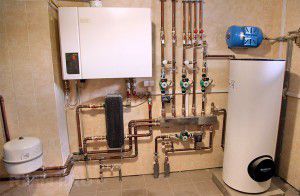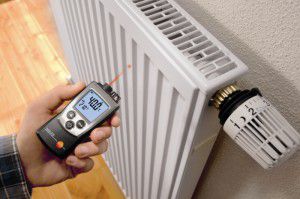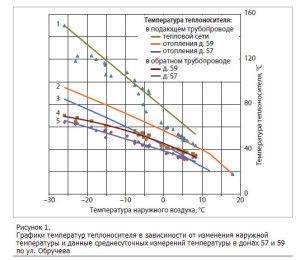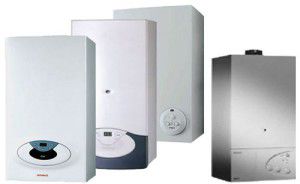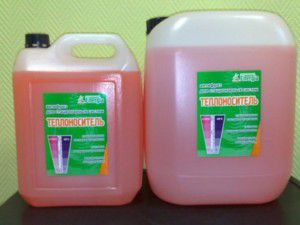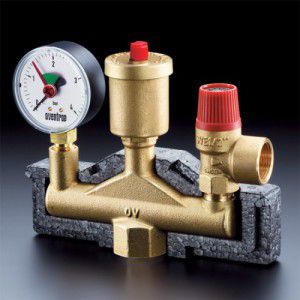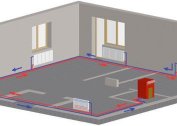The efficiency of the heating system depends on many factors. These include rated power, the degree of heat transfer of radiators and temperature conditions. For the last indicator, it is important to choose the right degree of heating of the coolant. Therefore, it is necessary to determine the optimum temperature in the heating system for water, radiators and the boiler.
What determines the temperature of water in the heating
For the correct operation of the heat supply, a graph of the water temperature in the heating system is required. According to it, the optimal degree of heating of the coolant is determined depending on the influence of certain external factors. Using it, you can determine what temperature the water in the heating batteries should be in a certain period of time the system works.
A common misconception is that the higher the degree of heating of the coolant, the better. However, this increases fuel consumption, increase operating costs.
Often, the low temperature of the heating batteries is not a violation of the heating standards of the room. The low-temperature heat supply system was simply designed. That is why the exact calculation of water heating should be given special attention.
The optimum temperature of the water in the heating pipes is largely dependent on external factors. To determine it, the following parameters must be taken into account:
- Heat loss at home. They are crucial for calculating any type of heat supply. Their calculation will be the first step in the design of heat supply;
- Boiler characteristics. If the operation of this component does not meet the design requirements, the water temperature in the heating system of a private house will not rise to the desired level;
- Material of pipes and radiators. In the first case, it is necessary to use pipes with a minimum thermal conductivity. This will reduce the heat loss in the system during transportation of the coolant from the boiler heat exchanger to the radiators. The opposite is important for batteries - high thermal conductivity. Therefore, the water temperature in central heating radiators made of cast iron should be slightly higher than that of aluminum or bimetal structures.
Is it possible to independently determine what temperature should be in the heating batteries? It depends on the characteristics of the system components. To do this, familiarize yourself with the properties of the batteries, boiler and heat supply pipes.
In a centralized heating system, the temperature of the heating pipes in the apartment is not an important indicator. It is important that the norms for heating air in living rooms are respected.
Heating norms in apartments and houses
In fact, the degree of water heating in pipes and radiators is a subjective indicator. It is much more important to know the heat transfer of the system. It, in turn, depends on what minimum and maximum water temperatures in the heating system can be achieved during operation.
For autonomous heat supply, the norms of central heating are quite applicable. They are detailed in the Decree of the PRF No. 354. It is noteworthy that the minimum water temperature in the heating system is not indicated there.
It is only important to observe the degree of heating of air in the room. Therefore, in principle, the temperature regime of one system may be different from another.It all depends on the influencing factors that were indicated above.
In order to determine what temperature should be in the heating pipes, you should familiarize yourself with the current standards. In their content there is a division into residential and non-residential premises, as well as the dependence of the degree of air heating on the time of day:
- In the rooms during the daytime. In this case, the norm of the heating temperature in the apartment should be + 18 ° C for rooms in the middle of the house and + 20 ° C in the corners;
- In the living rooms at night. Some reduction is allowed. But at the same time, the temperature of heating radiators in the apartment should provide respectively + 15 ° С and + 17 ° С.
The management company is responsible for complying with these standards. In case of violation, you can request a recalculation of payment for heating services. For autonomous heat supply, a temperature table is made for heating, where the values of the heating medium and the degree of load on the system are entered. Moreover, no one bears responsibility for violation of this schedule. This will affect the comfort of staying in a private house.
For centralized heating, it is mandatory to maintain the required level of air heating in the stairwells and non-residential premises. The temperature of the water in the heating batteries must be such that the air is heated to a minimum value of + 12 ° C.
Calculation of the temperature regime of heating
During the calculation of heat supply, the properties of all components must be taken into account. This is especially true for radiators. What is the optimal temperature in heating batteries - + 70 ° C or + 95 ° C? It all depends on the thermal calculation, which is carried out at the design stage.
First you need to determine the heat loss in the building. Based on the data obtained, a boiler with the appropriate power is selected. Then comes the most difficult stage of design - determining the parameters of heat supply batteries.
They must have a certain level of heat transfer, which will affect the water temperature graph in the heating system. Manufacturers indicate this parameter, but only for a specific mode of operation of the system.
If in order to maintain a comfortable level of air heating in a room, it is necessary to spend 2 kW of thermal energy - then radiators must have at least a heat transfer rate.
To determine this, you need to know the following values:
- Permissible maximum water temperature in the heating system - t1. It depends on the power of the boiler, the temperature limit of the effect on the pipes (especially polymer);
- Optimal temperature, which should be in the return heating pipes - t This is determined by the type of wiring of the mains (single-pipe or two-pipe) and the total length of the system;
- The required degree of heating the air in the room - t.
Having these data, you can calculate the temperature head of the battery according to the following formula:
Tnap = (t1-t2) * ((t1-t2) / 2-t3)
Next, to determine the power of the radiator, you should use this formula:
Q = k * F * Tnap
Where k - heat transfer coefficient of the heating device. This parameter must be specified in the passport;F - radiator area;Tnap - thermal pressure.
By varying various indicators of the maximum and minimum water temperatures in the heating system, it is possible to determine the optimal mode of operation of the system. It is important to correctly calculate the required power of the heater from the beginning. Most often, a low temperature indicator in heating batteries is associated with errors in heating design. Experts recommend adding a small margin to the received power of the radiator - about 5%. This will be needed in case of a critical drop in outdoor temperature in the winter.
Most manufacturers indicate heat dissipation for radiators in accordance with EN 442 standards for 75/65/20.This corresponds to the norm of the heating temperature in the apartment.
Water temperature in the boiler and heating pipes
After performing the above calculation, it is necessary to adapt the table of heating temperatures for the boiler and pipes. During operation of the heat supply, emergency situations should not occur, a frequent cause of which is a violation of the temperature schedule.
The normal water temperature in central heating batteries can be up to + 90 ° C. This is strictly monitored at the stage of preparation of the coolant, its transportation and distribution of residential apartments.
The situation with autonomous heat supply is much more complicated. In this case, control completely depends on the owner of the house. It is important to ensure that the temperature of the water in the heating pipes is not exceeded, beyond the scope of the schedule. This may affect system security.
If the water temperature in the heating system of a private house exceeds the norm, the following situations can occur:
- Pipeline damage. This is especially true for polymer lines, in which the maximum heating can be + 85 ° C. That is why the normal value of the temperature of the heating pipes in the apartment is usually + 70 ° C. Otherwise, deformation of the line may occur and a rush will arise;
- Excessive air heating. If the temperature of the heat supply radiators in the apartment provokes an increase in the degree of air heating above + 27 ° C - this is beyond the normal range;
- Reducing the life of heating components. This applies to both radiators and pipes. Over time, the maximum temperature of the water in the heating system will lead to breakage.
Also, a violation of the water temperature graph in the autonomous heating system provokes the formation of air jams. This occurs due to the transition of the coolant from a liquid state to a gaseous one. In addition, this affects the formation of corrosion on the surface of the metal components of the system. That is why it is necessary to accurately calculate what temperature should be in the heat supply batteries, given their material of manufacture.
Most often, a violation of the thermal regime of operation is observed in solid fuel boilers. This is due to the problem of adjusting their power. When a critical temperature level is reached in the heating pipes, it is difficult to quickly reduce the boiler output.
The effect of temperature on the properties of the coolant
In addition to the above factors, the temperature of the water in the heat supply pipes affects its properties. The principle of operation of gravity heating systems is based on this. With an increase in the level of heating of water, its expansion occurs and circulation occurs.
However, in the case of the use of antifreeze agents, exceeding the norm, the temperature in the heating batteries can lead to other results. Therefore, for heat supply with a coolant other than water, you should first find out the acceptable indicators of its heating. This does not apply to the temperature of central heating radiators in the apartment, since antifreeze fluids are not used in such systems.
Antifreeze is used if there is a likelihood of low temperatures affecting the radiators. Unlike water, it does not begin to transition from a liquid to a crystalline state when it reaches 0 ° C. However, if the work of heat supply is outside the norms of the temperature table for heating in a big way - the following phenomena can occur:
- Foaming. This entails an increase in the volume of coolant and, as a consequence, an increase in pressure. The reverse process when cooling antifreeze will not be observed;
- Limescale formation. The composition of antifreeze includes a certain amount of mineral components.If the temperature of the heating in the apartment is violated upwards, their precipitation begins. Over time, this will lead to clogging of pipes and radiators;
- Increase in density. There may be malfunctions in the circulation pump if its rated power was not designed for such situations.
Therefore, it is much easier to monitor the temperature of the water in the heating system of a private house than to control the degree of heating of antifreeze. In addition, compounds based on ethylene glycol during evaporation emit a gas harmful to humans. Currently, they are practically not used as a coolant in autonomous heat supply systems.
Before pouring antifreeze into the heating, replace all rubber gaskets with paranit ones. This is due to the increased permeability of this type of coolant.
Ways to normalize the temperature of heating
The minimum value of the water temperature in the heating system is not the main threat to its operation. This, of course, affects the microclimate in residential premises, but in no way affects the functioning of the heat supply. In case of exceeding the water heating rate, emergency situations can occur.
When drawing up a heating scheme, it is necessary to provide for a number of measures aimed at eliminating a critical increase in water temperature. First of all, this will lead to an increase in pressure and an increase in the load on the inner surface of pipes and radiators.
If this phenomenon is single and short-lived - the components of the heat supply may not be affected. However, such situations arise under the constant influence of certain factors. Most often, this is the wrong operation of a solid fuel boiler.
To avoid their occurrence, it is recommended to upgrade the heating as follows:
- Security Group Setup. It includes an air vent, a bleed valve and a pressure gauge. If the water temperature reaches a critical level, these components will remove the excess coolant, thereby ensuring normal circulation of the liquid for its natural cooling;
- Mixing unit. It connects the return and supply pipe. Additionally, a two-way valve with a servo drive is installed. The latter is connected to a temperature sensor. If the value of the degree of heating exceeds the norm, the valve will open and there will be a mixture of flows of hot and cooled water;
- Electronic heating control unit. It captures the temperature of water in various parts of the system. In case of violation of the thermal regime, he will give the appropriate command to the boiler processor to reduce power.
These measures will help prevent malfunctioning of the heating system even at the initial stage of the problem. The most difficult thing is to regulate the level of water temperature in systems with a solid fuel boiler. Therefore, for them, special attention should be paid to the choice of parameters of the safety group and the mixing unit.
The influence of water temperature on its circulation in heating is described in detail in the video material:
